Every motorcycle purchase starts as a vision, whether it’s a daily driver or a ground-up custom. But as soon as you start swapping parts, reality hits in the form of receipts, and your dream machine can quickly get bogged down by the staggering cost of new parts, turning a passion project into an inspiration-robbing money pit. But for the savvy builder, there’s a solution that’s been fueling the scene since its infancy: the secondhand parts market.
Buying used isn’t just about saving a buck; it’s about building smarter. Sometimes, it’s the only way to get your hands on period-correct components for a vintage restoration, and it’s an environmentally sound way to keep good parts in circulation and out of the landfill. While secondhand parts can be had from a variety of sources, the secret is knowing what to look for and where to look.

We recently crossed paths with Sun Coast Cycle Sports’ David Voelker, discussing how to navigate the wide world of used parts and found a whole lot of common ground. After 20 years of growing his business from a garage hobby to one of the country’s leading suppliers of secondhand powersports components, Voelker’s seen it all, and we thought it worthwhile to share some of that wisdom.
So, whether you’re modifying a daily driver to stand out from the herd, retrofitting modern parts to an old street machine or undertaking some unplanned repairs from your latest ‘whoopsie,’ here is our list of the kinds of parts you should consider buying used, and the ones you should definitely avoid.
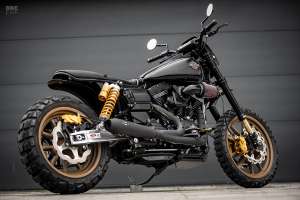
The Green Light List: Five Parts to Score Secondhand
Engines: Your Machine’s Heart and Soul
Pound for pound, it’s the priciest piece of your motorcycle, and for good reason, considering all the rotating bits and tight clearances housed inside. It’s the heart of your bike and the core of your riding experience, and if you find yourself shopping for a complete powerplant, the sticker shock of a brand-new engine is liable to derail your project completely.
Used engines have been a staple in the secondhand scene since the days of public pick-n-pulls, and just like the automotive scene, a staggering number of motorcycles are written off with healthy, good-running engines. And the cost savings can be astronomical. Say, for instance, you need a complete engine for a 2008 Harley Dyna. That can set you back $7,000 or more for a new engine from the usual sources, while a used engine goes for 1/4 of that. Those are the kind of margins that make or break projects when you’re the one footing the bill.
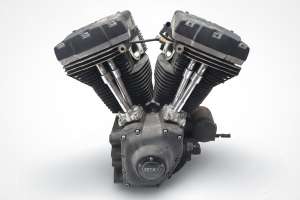
But, like many things, a used engine can be a dice roll if you don’t shop smart. If you’re pinching pennies, a non-running engine should always be considered as such, and you should never take a seller’s word as law without seeing the proof yourself—especially on Facebook Marketplace. Trustworthy secondhand sellers like Sun Coast will go out of their way to prove the quality of their used parts, providing odometer readings, videos of the engine running before disassembly and a warranty if they’re really good.

Wheels: The Foundation of Your Bike’s Stance
Whether it’s spokes or mags, just about any wheel will get you down the road, but as connoisseurs of customization, we hold ourselves to a higher standard than that. Wheels set a visual tone, define your bike’s stance and are an integral part of its handling. One of the hardest decisions to make as far as a motorcycle’s chassis is concerned, we understand the implications of altering spoke counts and increasing diameters by an inch.
The aftermarket understands our affinity for rims, and the web has flooded in recent years with options in every diameter and outlandish colorway you can dream up. Quality is a case-by-case basis, but I think we can all agree that not every aftermarket wheel you’ll get off the shelf is built to the same standards as OEM.
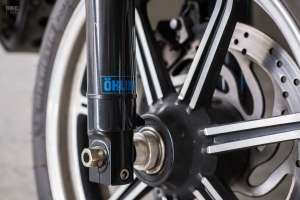
Then there’s also the topic of fitment. Aftermarket wheels are designed to fit as many models as possible so they can sell a boatload of them, but that doesn’t mean they will fit like stock ones. Machining spacers and sourcing new hardware both come with the territory, so if you’re looking for a true bolt-on solution, used wheels in verified condition can be a better way to go. And that doesn’t mean you’re stuck with stock. Wheels from a higher-spec model, or a bike several years newer may all fit the same, and could be just the thing to set your machine apart from the herd.
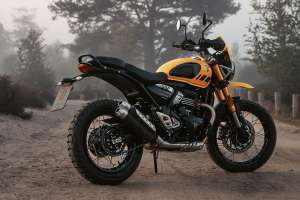
Exhaust Systems: The Decibels that Move You
We tend not to put much thought into exhaust systems until it’s time to replace them, and that’s the moment you realize just how much a collection of pre-bent tubing can cost. Whether you put a big kink in a factory header pipe or you’re looking to upgrade your stock system, exhaust parts can be ridiculously expensive, but don’t take my word for it.
Check the parts fiche for your factory exhaust system. A complete system for a Yamaha FZ07 lists for over $1,000. Ditto for the full Yoshimura system I wish my CRF450RL had, coming in just under $950. Wouldn’t it be nice if someone had already taken the heavy hit on the MSRP?
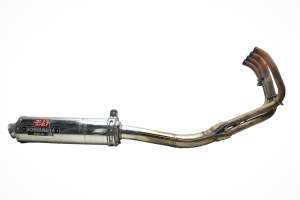
Other than impacts or instances of extreme corrosion, exhaust systems don’t generally wear out, and they’re one of the most commonly swapped items. That $1,000 FZ07 system, used examples can be sourced from the people who had to have an Akrapović. And for my 450RL, countless riders upgrade their dual sports with a full exhaust system, and then revert them to stock for resale. Sure, it takes patience to wait around for the right parts to come up used, but at the end of the day, you can put a price on saving a buck.
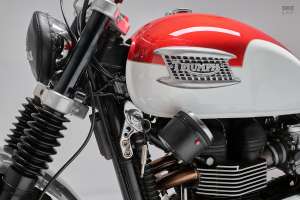
Fuel Tanks: Your Soulfull Centerpiece
Most items on your motorcycle are built to take a hit, even the fuel tank, but an unsightly dent in your tank will bother you for the rest of your days. While some damage can be touched up affordably, larger repairs involve metalwork, filler and paint by a qualified professional—and the results aren’t always perfect.
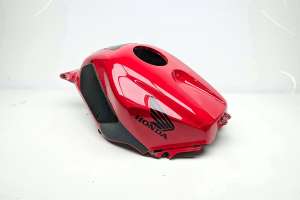
If factory fit and finish is the goal, your best avenue to get there is usually a good used part. It may cost more than you expected, but compare that to the price you’ll pay to get something fixed at the body shop, or the expense for paint and prep work on a whole new tank. If you’ve ever received an estimate for paint and bodywork before, you’ll understand my point.

Seats and Body Panels: The Finishing Touches
Every motorcycle is different, and bodywork is one of the areas that’s the most difficult to establish a rule for. Dual sports, standards, cruisers and sport bikes are all built differently, but a few themes remain consistent.
These are the kind of parts that are readily available if your bike isn’t that old. Motorcycles are written off with good seats and perfect panels on the high side all the time. Like exhaust systems, these panels are also frequently swapped by owners who customize their bikes—often in showroom condition.
Like some of the other categories, you’d be appalled to see what parts like radiator shrouds, seats and decals list for from the dealership. You might save as much as 40% buying a good used radiator shroud versus a new one from the dealership—and that may not even include the decal.

The Hard Pass List: Two Parts to Always Buy New
Tires: Your Only Connection to the Road
This may seem like a no-brainer, but I promise that if you spend enough time in the motorcycle hobby, you’ll be confronted with tempting opportunities to save money on tires. Sometimes it’s a set that barely has any miles for super cheap, or a new tire that’s a few years old but has never been mounted. It’s usually not worth it for one of two reasons.
There are clear exceptions, but generally, any sort of used tire shouldn’t be considered safe. Rubber has a shelf life, that’s why tire date codes exist, and old tires are a one-way ticket to one of the most common types of wrecks in the two-wheeled world—the low-side slide. And there’s no way to guarantee what that tire has or hasn’t seen (even in a short amount of time), from wildly incorrect tire pressure, burnouts or even a slow-leaking puncture.
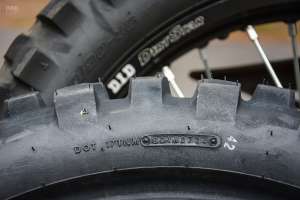
Also, remember that you need to spend the money or the time and effort to get those tires mounted. And by the time you’re done with all that rigmarole, do you really want that rubber to be anything less than perfect?
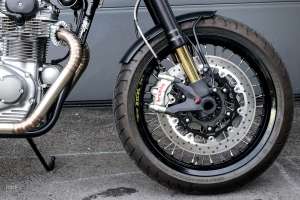
Brakes: Your Saving Grace
Like tires, used brake components are something you want to avoid under most circumstances. Parts that provide friction, like brake pads, shoes and rotors, are all subject to intense heat and brake bedding procedures that render them best for one-time use. Did the previous owner abuse the brakes repeatedly? That leads to several thermal stress conditions that render these parts ineffective going forward. Excessive heat glazes brake pads, and improper installation can lead to uneven wear, all decreasing their coefficient of friction. Rotors take a beating as well, and excessive heat can easily warp them and cause microscopic fractures in the metal.

While you generally want to avoid secondhand brake parts that do the hard work of bringing your bike to a stop, other components can be deemed safe on a case-by-case basis. Hydraulic components like master cylinders and calipers are great parts to source used, but should be closely examined upon installation to verify the condition of O-rings and seals. A rebuild kit and a thorough cleaning can extend the life of these parts for decades. Brake hoses and hard lines have a shorter lifespan, as they’re subject to abrasion and rust-jacking. Since a brake system is only as strong as its weakest link, every component warrants extra attention, making sure that the right-hand lever inspires nothing but confidence when it hits the fan.
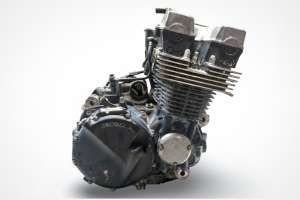
Shop Smart, Ride Safe
Building a custom motorcycle is a journey, and making smart decisions along the way is part of the craft. The used parts market is an invaluable resource, but it all comes down to your source.
For over 20 years, Sun Coast Cycle Sports has been serving the powersports community, growing from a family-owned operation in a home garage to a trusted online retailer with over 100,000 new and used parts in stock. With a focus on quality, competitive pricing and fast fulfillment, Sun Coast Cycle Sports aims to provide the peace of mind that’s essential when buying secondhand. Check out Sun Coast’s massive online inventory of parts (many of which are pictured throughout this article) for your next project, and tell ’em Bike EXIF sent ya.
This guide was created in partnership with Sun Coast Cycle Sports.
